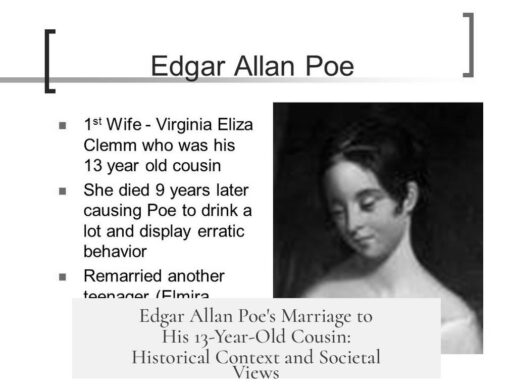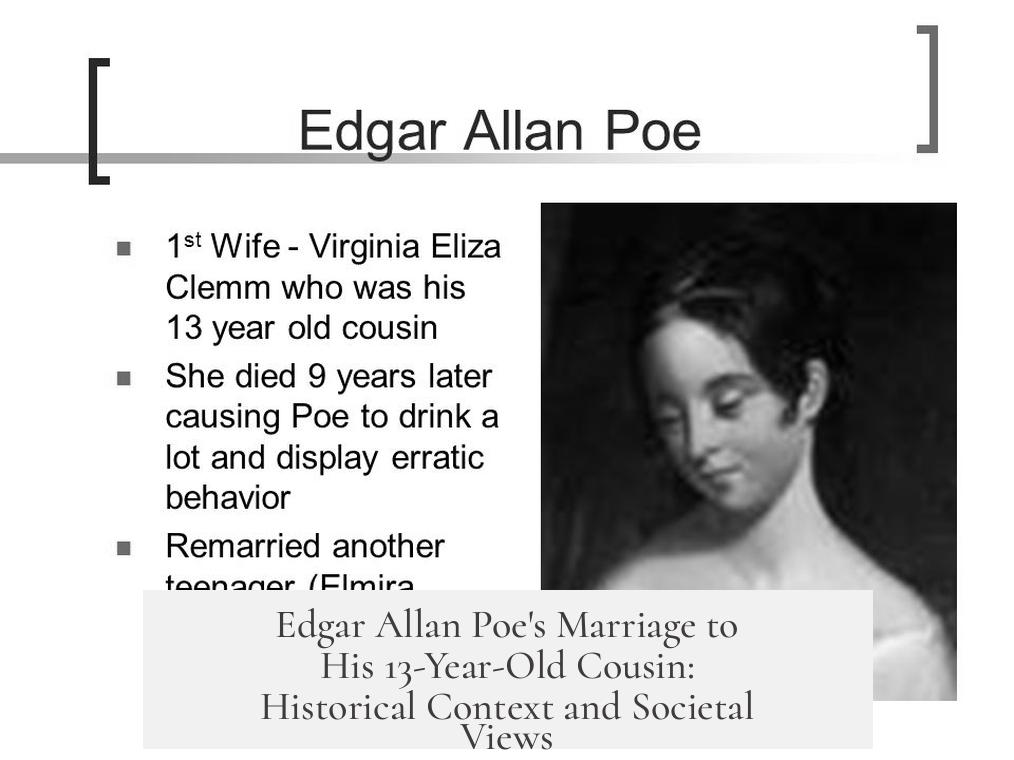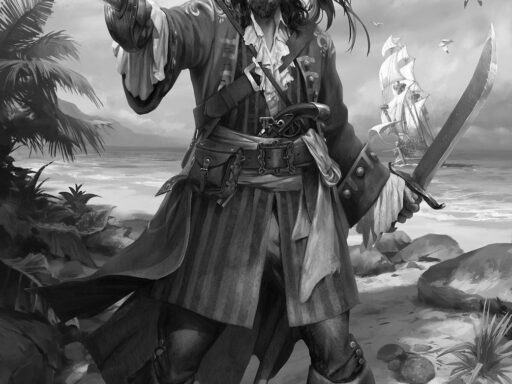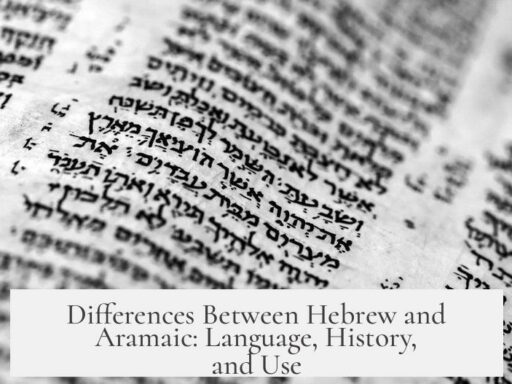Edgar Allan Poe’s marriage to his 13-year-old first cousin, Virginia Clemm, was legally permitted during the 19th century, but it was socially unusual and potentially scandalous at the time.
In the early 1800s, societal norms around marriage differed from today. Marriages involving teenagers were not uncommon. However, brides as young as 13 were rare, and this age often raised eyebrows even then. Marrying a girl in her late teens, 16 or 18, would have been widely accepted. Marrying one as young as 13 was more exceptional, thus subject to social scrutiny.
Legally, the marriage between Poe and Virginia was valid. Maryland’s age of consent in the 1800s was set at 10 years old, provided the girl’s guardians agreed. Thus, the actual age of Virginia did not violate any laws at the time. The guardianship approval played a key role in sanctioning such unions. Marrying a minor, especially first cousins as in Poe’s case, was legal and often practiced, particularly in certain communities where family alliances were common.
Despite this legality, the sizeable age difference between Poe, aged 27, and Virginia, just 13, was unusual. This gap likely contributed to social discomfort with their marriage. Some reports indicate Poe himself may have recognized this. On the marriage certificate, he listed Virginia as 21 rather than 13—possibly to reduce social stigma or avoid questions regarding guardianship.
An interesting fact is that Poe and Virginia publicly re-performed the marriage ceremony a year later when she was 14. This suggests an effort to maintain propriety or public acceptance. It may also imply Poe’s awareness that marrying a 13-year-old was borderline controversial, but a 14-year-old bride was more socially acceptable.
Family perspectives add context. Neilson Poe, Edgar’s uncle, allegedly offered to take responsibility for Virginia, possibly to protect her from marrying so young. Whether this offer was serious or merely protective concern is unclear. However, Neilson seemed to accept the marriage over time, reflecting possibly evolving attitudes as Virginia aged.
Privacy during the 19th century further complicates understanding public attitudes. Private lives were strictly guarded. Discussions about marriage and especially sexual matters seldom entered public discourse. Gossip and rumors surrounded Poe due to his literary rivals, muddying clear historical records.
Moreover, attempting to draw direct conclusions about Poe’s personal life from his literary works is risky. His writings are primarily fiction, not autobiographical confessions. Rumors and speculations seeped into accounts of Poe’s life, making fact-finding challenging.
- Teenage marriages, while more common than today, generally involved older teens, not girls as young as 13.
- Maryland’s age of consent being 10 made the marriage legal but did not remove social implications.
- The large age gap between Poe and Virginia was uncommon and viewed with discomfort.
- Poe’s falsification of Virginia’s age on the marriage certificate hints at social concerns over the young bride.
- Public re-ceremony of the marriage indicates an effort at social acceptability.
- Privacy norms limited public discussion of such marriages, keeping exact public opinion somewhat obscure.
In sum, Poe’s marriage to his 13-year-old cousin was legally permissible and not extraordinarily rare for its time but was still unusual and seen as borderline scandalous due to Virginia’s young age and the substantial age difference. Contemporary societal norms permitted such unions under guardian consent, but many would have regarded this marriage with some degree of unease.
So, Edgar Allan Poe Married His 13-Year-Old First Cousin. Was That Considered Okay at the Time?
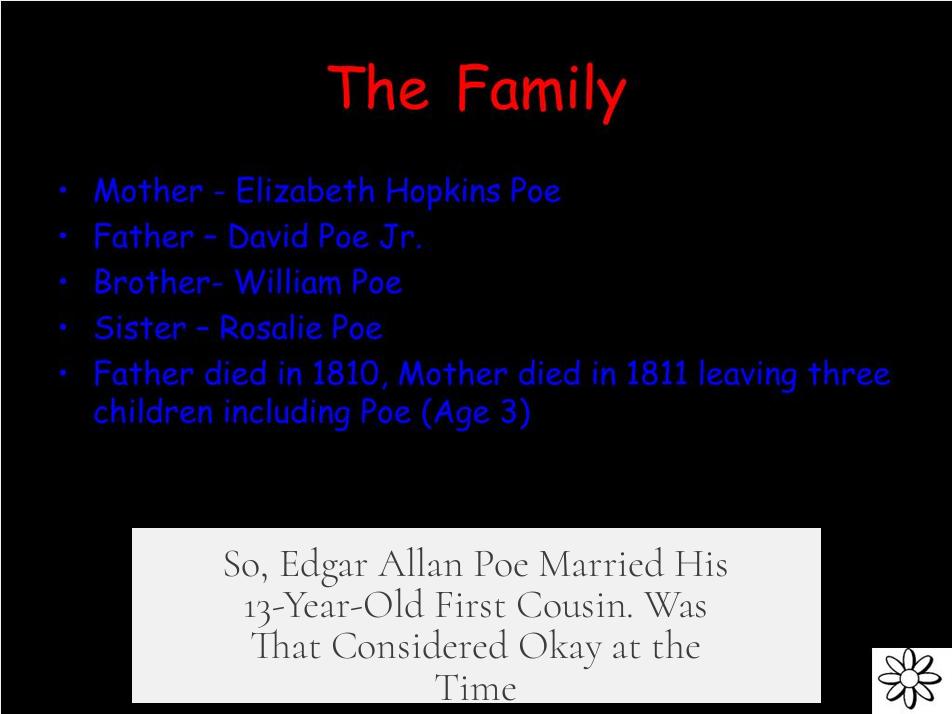
Yes, legally and socially, it was possible and not as shocking as you might think today—but it was still unusual and raised some eyebrows even then. Let’s unpack this uneasy question with some historical context, baffling legal quirks, and the peculiar personal details surrounding one of the most famous American writers.
Edgar Allan Poe’s marriage to his first cousin, Virginia Clemm, who was just 13 years old at the time, might send a modern audience running for the fainting couch. But in the 19th century, things weren’t as black and white. Was it “okay” then? Sort of. Legal? Absolutely. But was it the norm or socially embraced? Not quite.
Marriage Norms and Ages: What Was Typical in the 1800s?
Today’s average age for first marriage in the U.S. generally hovers in the late 20s or early 30s. Back in Poe’s day, that average was quite a bit younger but still usually above 20 years for women. Official census data starting in 1890 shows the average age of first marriage for women around 22 years old.
While teen brides were definitely a thing in the 19th century, they were usually in their mid-to-late teens. Marriages involving young teenagers aged 16 or 17 weren’t headline news. But a 13-year-old? That was unusual, even then. It wasn’t the public norm, and such young marriages could stir suspicion and gossip.
Curiously, Maryland—the state where Poe married Virginia—had an age of consent as low as 10 years old during that period, provided the girl’s guardians approved. This meant that legally, marrying a 13-year-old was not only possible but technically above board, assuming family consent.
The Age Gap That Raised Eyebrows
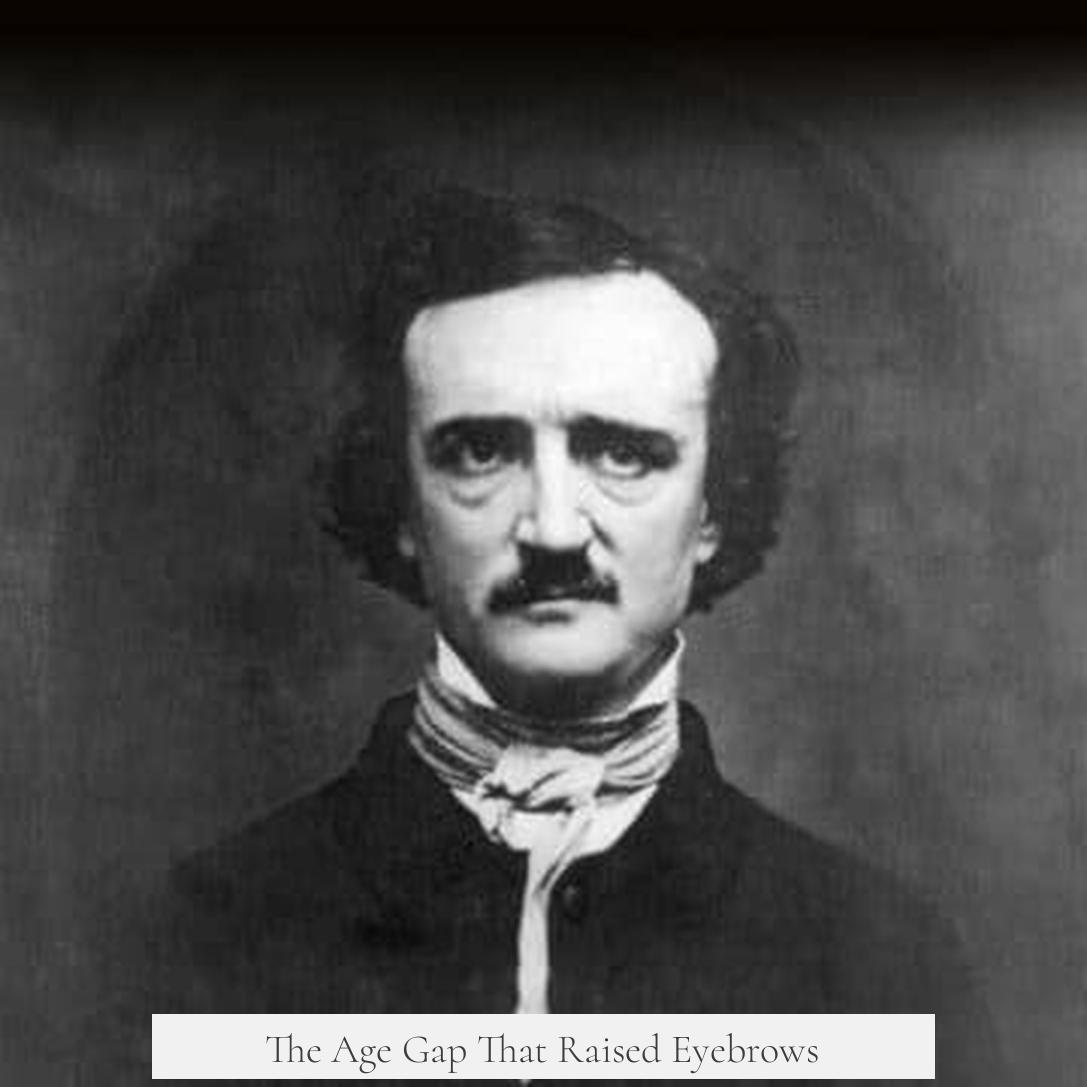
The bigger social eyebrow-raiser was Poe himself. At 27, marrying a girl literally half his age was unconventional. Age disparities like this, especially involving very young brides, often invited scrutiny and whispered critiques.
It’s important to realize that legal permission didn’t equal social acceptability. The practice pushed boundaries for even that era’s standards.
Was Poe Concerned About Societal Perception?
Interestingly, Edgar Allan Poe seemed aware of how strange the union appeared. Legend has it he listed Virginia’s age as 21 on the original marriage certificate. Why fudge the truth? Some say Poe wanted to dodge social disapproval or avoid complications regarding Virginia’s guardians. Others suggest he hoped to smooth over any legal or social hurdles.
They publicly remarried a year later when Virginia was 14, which might indicate Poe thought 14-year-old brides were a more acceptable or at least less scandalous proposition.
Poe’s Relationship With Virginia: Affectionate or Awkward?
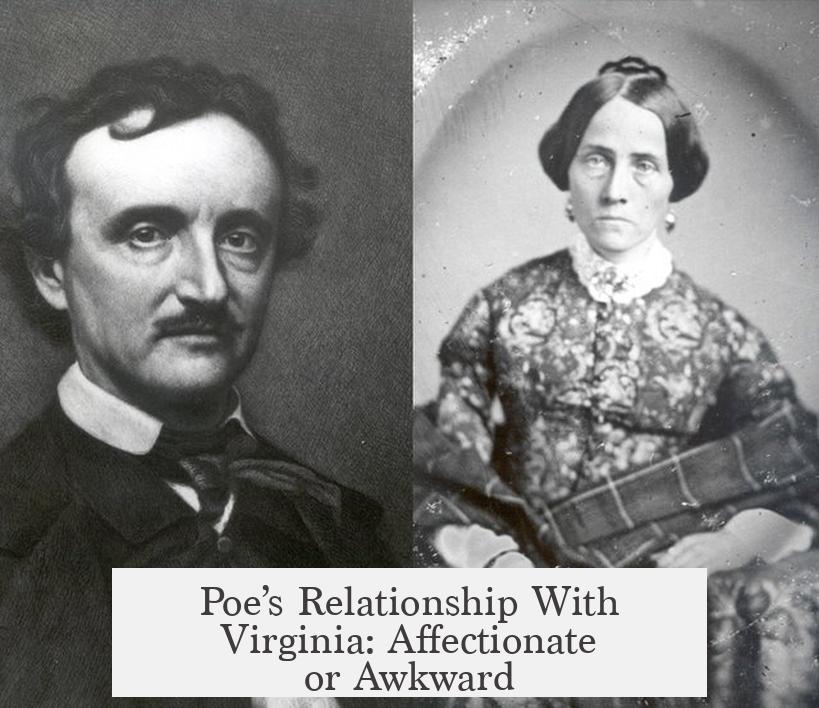
Poe’s letters to Virginia provide glimpses into their relationship. He called her “Sissy” and “my darling little wifey” before they were even married, addressing her with affectionate terms that suggest fondness rather than mere familial duty. Whether these terms sound endearing or creepy is your call.
His letter to Virginia and her mother in August 1835 mentions: “Virginia, my love, my own sweetest Sissy, my darling little wifey, think well before you break the heart of your Cousin, Eddy.” The warmth is evident, though the affection might feel intense given her youth.
After Virginia’s tragic death from tuberculosis in 1847, contemporaries noted Poe’s peculiar ways of expressing affection. Some said his showing of love bordered on the strange, though nobody was explicit about what that “strangeness” entailed. One touching fact: Virginia kissed Poe’s portrait before she died, signaling a deep bond.
What Did Virginia’s Family Think?
Virginia’s older cousin, Neilson Poe, reportedly might have been concerned about how young she was when she married Edgar. There’s speculation Neilson offered to take Virginia in to shield her from such an early marriage. But if he was uneasy, he seemed to come around gradually—time probably dulled worries as Virginia grew older and her role as wife solidified.
The Privacy of Private Lives in Poe’s Time
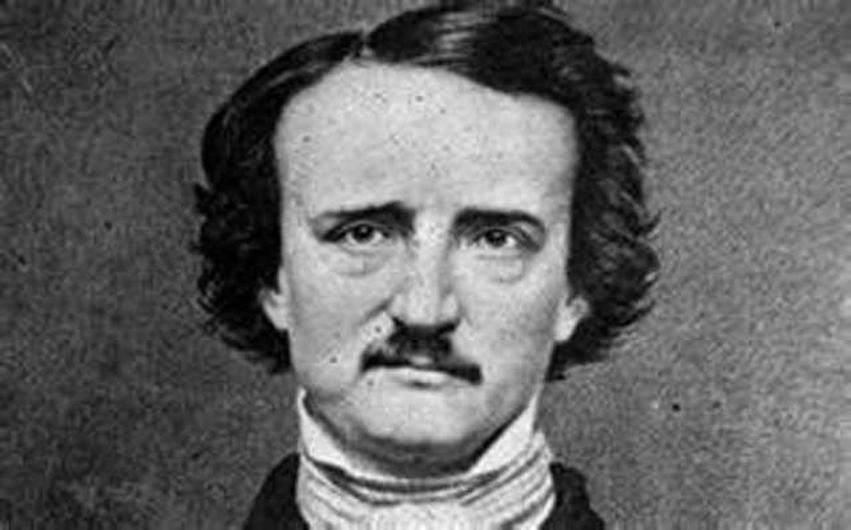
It’s key to remember: 19th-century private lives stayed private. The intimate details of marital relations were rarely discussed publicly or even in personal correspondence. So, we have limited clues about how they lived their married life—or what any age disparities meant in practice.
Rumors and scandals swirled around Poe—he was never free from controversy—but separating fact from fiction is challenging. Poe’s enemies often exaggerated or invented tales, so relying on letters and verified documents is our safest bet.
Should We Judge Past Societies by Today’s Standards?
Legal definitions matter here. Marriage was understood as a serious contract, merging two individuals into one social and economic unit. Age of consent laws, commonly ranging from 10 to 12 years old during that period in America, prioritized guardians’ approval over strict age limits.
Stephen Robertson, a historian from the University of Sydney, suggests people in the 1800s weren’t fixated on the exact number of years a girl had lived. Instead, they judged by whether she seemed physically and mentally “ready” to leave childhood behind.
So, in a way, Poe’s marriage was both completely legal and not entirely outside society’s reluctant norms of the time. But it remained on the edge of what was socially acceptable.
What Can We Learn From This Odd Historical Fact?
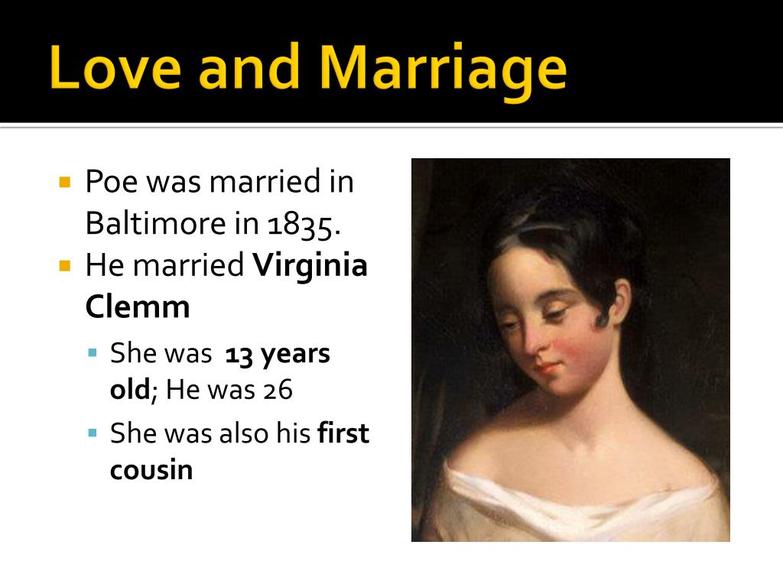
- Social norms evolve, but legality and social acceptability don’t always line up perfectly.
- Historical figures lived lives that might look very strange through our modern eyes.
- It’s important to study context. Poe’s marriage to Virginia wasn’t a scandal-free arrangement, but it also wasn’t headline-grabbing outrageous in his day.
- Personal affection and love are complicated, expressed in times and ways different from ours.
- The world changes. Today, such a marriage would be illegal and unacceptable, but once, it was a complicated gray area.
Still Curious?
Do you think people then understood the power imbalance Poe had with young Virginia—or did societal focus rest elsewhere? Does knowing the legal consent age was 10 help or hurt our perception? And what can Poe’s marriage teach us about judging historical figures fairly?
“It is useless to disguise the truth that when Virginia goes with N.P. that I shall never behold her again.” — Poe, in his letter before the marriage.
At the end of the day, history holds contradictions. Poe’s quirky, intense life reminds us that even literary geniuses can be tangled in social oddities and personal complexities.
So, yes, Edgar Allan Poe’s marriage to his 13-year-old cousin was legal and not unheard of—but it was unusual, sometimes questioned, and certainly colored by the mores of a very different time.
